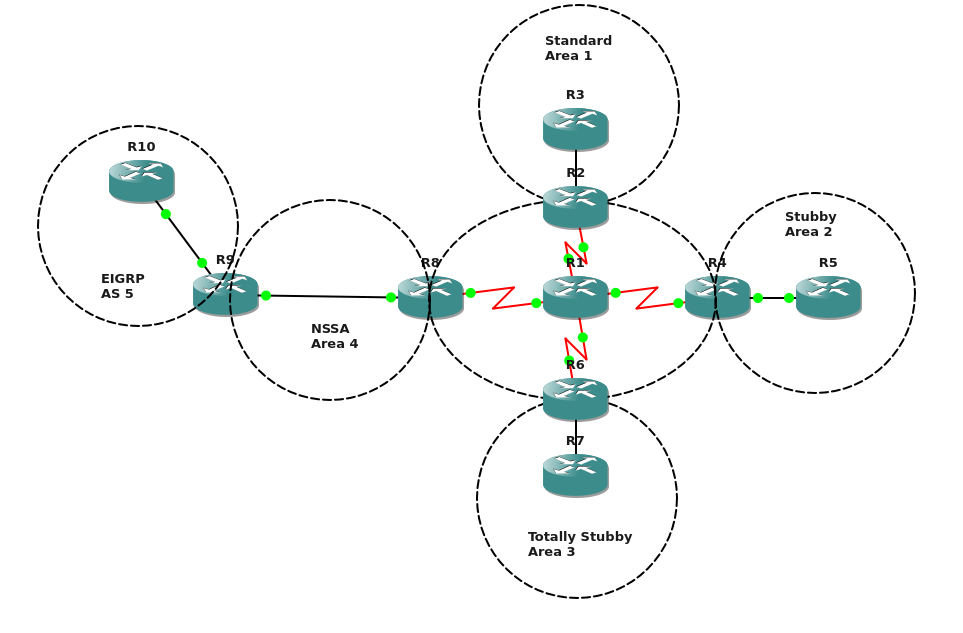OSPF Area types

In this example I was playing around with OSPF areas. In the middle we have a backbone area with a standard area and three types of stub areas.
R1 R2 R3 R4 R5 R6 R7 R8 R9 R10
In R1 we have all the routes we are expecting to see advertised from around the network.
R1#sh ip route Codes: C - connected, S - static, R - RIP, M - mobile, B - BGP D - EIGRP, EX - EIGRP external, O - OSPF, IA - OSPF inter area N1 - OSPF NSSA external type 1, N2 - OSPF NSSA external type 2 E1 - OSPF external type 1, E2 - OSPF external type 2 i - IS-IS, su - IS-IS summary, L1 - IS-IS level-1, L2 - IS-IS level-2 ia - IS-IS inter area, * - candidate default, U - per-user static route o - ODR, P - periodic downloaded static route Gateway of last resort is not set O E2 192.168.8.0/24 [110/20] via 192.168.3.2, 00:28:34, Serial0/3 172.16.0.0/32 is subnetted, 5 subnets O E2 172.16.0.10 [110/20] via 192.168.3.2, 00:28:34, Serial0/3 O IA 172.16.0.5 [110/75] via 192.168.1.2, 00:28:37, Serial0/1 O IA 172.16.0.7 [110/75] via 192.168.2.2, 00:28:35, Serial0/2 C 172.16.0.1 is directly connected, Loopback0 O IA 172.16.0.3 [110/75] via 192.168.0.2, 00:28:40, Serial0/0 O IA 192.168.4.0/24 [110/74] via 192.168.0.2, 00:29:12, Serial0/0 O IA 192.168.5.0/24 [110/74] via 192.168.1.2, 00:29:10, Serial0/1 O IA 192.168.6.0/24 [110/74] via 192.168.2.2, 00:29:07, Serial0/2 O IA 192.168.7.0/24 [110/74] via 192.168.3.2, 00:29:03, Serial0/3 C 192.168.0.0/24 is directly connected, Serial0/0 C 192.168.1.0/24 is directly connected, Serial0/1 C 192.168.2.0/24 is directly connected, Serial0/2 C 192.168.3.0/24 is directly connected, Serial0/3 R1#
We also see this in our standard area as the link state advertisements are passing without any filtering.
When we get into our stubby area things change a little. All of a sudden we’re not seeing the route to the EIGRP network anymore. Instead we’re seeing a default route pointing out of the stub.
R5#sh ip route
Codes: C - connected, S - static, R - RIP, M - mobile, B - BGP
D - EIGRP, EX - EIGRP external, O - OSPF, IA - OSPF inter area
N1 - OSPF NSSA external type 1, N2 - OSPF NSSA external type 2
E1 - OSPF external type 1, E2 - OSPF external type 2
i - IS-IS, su - IS-IS summary, L1 - IS-IS level-1, L2 - IS-IS level-2
ia - IS-IS inter area, * - candidate default, U - per-user static route
o - ODR, P - periodic downloaded static route
Gateway of last resort is 192.168.5.1 to network 0.0.0.0
172.16.0.0/32 is subnetted, 4 subnets
C 172.16.0.5 is directly connected, Loopback0
O IA 172.16.0.7 [110/149] via 192.168.5.1, 00:34:05, FastEthernet0/0
O IA 172.16.0.1 [110/75] via 192.168.5.1, 00:34:07, FastEthernet0/0
O IA 172.16.0.3 [110/149] via 192.168.5.1, 00:34:07, FastEthernet0/0
O IA 192.168.4.0/24 [110/148] via 192.168.5.1, 00:34:07, FastEthernet0/0
C 192.168.5.0/24 is directly connected, FastEthernet0/0
O IA 192.168.6.0/24 [110/148] via 192.168.5.1, 00:34:08, FastEthernet0/0
O IA 192.168.7.0/24 [110/148] via 192.168.5.1, 00:34:08, FastEthernet0/0
O IA 192.168.0.0/24 [110/138] via 192.168.5.1, 00:34:08, FastEthernet0/0
O IA 192.168.1.0/24 [110/74] via 192.168.5.1, 00:34:08, FastEthernet0/0
O IA 192.168.2.0/24 [110/138] via 192.168.5.1, 00:34:08, FastEthernet0/0
O IA 192.168.3.0/24 [110/138] via 192.168.5.1, 00:34:08, FastEthernet0/0
O*IA 0.0.0.0/0 [110/11] via 192.168.5.1, 00:34:09, FastEthernet0/0
R5#
We still see all the expected inter area routes within our OSPF network. This is not the case with the totally stubby area.
In the totally stubby area all the inter area routes are also filtered out and we just get the default route. It’s useful if you have small remote sites with less powerful routers and you don’t want to send them the whole routing table.
R7#sh ip route
Codes: C - connected, S - static, R - RIP, M - mobile, B - BGP
D - EIGRP, EX - EIGRP external, O - OSPF, IA - OSPF inter area
N1 - OSPF NSSA external type 1, N2 - OSPF NSSA external type 2
E1 - OSPF external type 1, E2 - OSPF external type 2
i - IS-IS, su - IS-IS summary, L1 - IS-IS level-1, L2 - IS-IS level-2
ia - IS-IS inter area, * - candidate default, U - per-user static route
o - ODR, P - periodic downloaded static route
Gateway of last resort is 192.168.6.1 to network 0.0.0.0
172.16.0.0/32 is subnetted, 1 subnets
C 172.16.0.7 is directly connected, Loopback0
C 192.168.6.0/24 is directly connected, FastEthernet0/0
O*IA 0.0.0.0/0 [110/11] via 192.168.6.1, 00:37:02, FastEthernet0/0
R7#
The not so stubby area is pretty much the hack for if things change. I once saw a design utilising not so stubby areas alongside stubby and totally stubby in a green field network and I think the network designer was trying to show off how clever he was however it had the opposite effect.
The NSSA will pass type 5 LSAs (routes external to the OSPF domain, in this case the EIGRP redistributed routes) through as type 7 LSAs. This allows you to tack on a different routing domain to your stubby or totally stubby area while still having the smaller routing table.